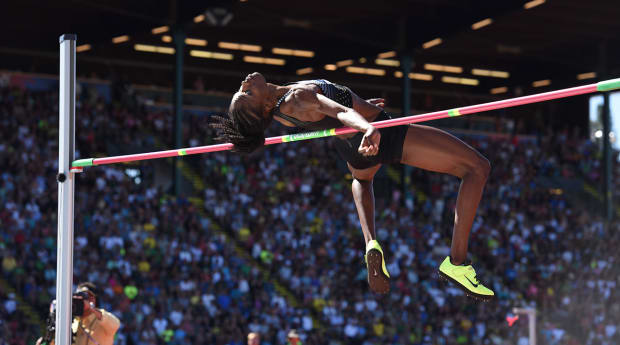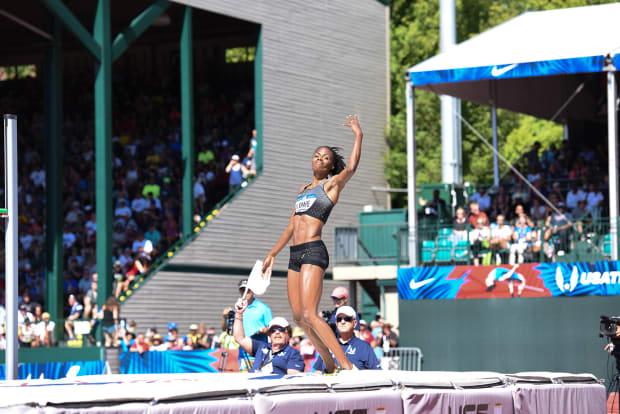From a battle with breast cancer to a global pandemic, 36-year-old mother of three Chaunte Lowe isn't letting any challenge or obstacle get in the way of making her fifth U.S. Olympic team.
ANAHEIM, Calif. — Bald, beautiful and powerful, Chaunte Lowe sat on a podium here in late January and smiled radiantly at an NCAA convention audience. She projected confidence. She’d been diagnosed with breast cancer in the summer of 2019; she’d undergone a double mastectomy; she’d fought through chemotherapy; and none of that was going to stop her from making her fifth U.S. Olympic team as a high jumper come June.
It was an attitude we’d all aspire to have. But around the sport—and assuredly in a small corner of her own relentlessly optimistic mind—there were doubts.
Any 36-year-old athlete is fighting the tyranny of time, but what about a 36-year-old mother of three who is recovering from a body-ravaging disease? From chemo to Tokyo in less than a year seemed impossible.
Then the pandemic struck. Beyond the horrific loss of life globally and nationally, it also smashed a hole in the Olympic movement. Tokyo 2020 became Tokyo 2021, to the consternation of thousands of aspiring Olympians. Carefully laid plans were torn up. For many athletes, the timing could not have been worse.
For Lowe, the timing could not have been better.
“I needed every single day of that time to be able to train,” she said. “I’ve come back from pregnancy three times, so I know that it’s not impossible. I know I could have done it [in 2020], but it would have been a lot harder.”

Nothing seems too hard for Lowe. The fact that she barely even blinked after her cancer diagnosis is consistent with her outlook on life, and the way she’s lived it since her youth.
Growing up in a troubled family in California, young Chaunte used to walk miles to church by herself. She said her mother was in the throes of addiction and her father was incarcerated. Bills went unpaid, and utilities were turned off. After staying for a while with an aunt, she went to live permanently with her grandmother.
Faith, she says, pulled her through a childhood fraught with peril. Her grandma went to church several times a week, and her uncle was the pastor at Riverside Faith Temple. That became her anchor.
Along the way, she came to realize she possessed a remarkable natural bounce, in both a literal and figurative sense. She could rise—above troubles and off the ground—in a way that other kids could not match. “I didn’t walk anywhere,” she said. “I jumped.” She jumped her way to a scholarship at Georgia Tech.
Lowe made her first Olympic team in 2004 as a 20-year-old sophomore at Tech. She retroactively won a bronze medal from the ’08 Olympics in Beijing, after later drug tests stripped the results of three competitors who finished ahead of her. She jumped an American outdoor record 2.05 meters in 2010 and an indoor record of 2.02 in 2012.
She won the world indoor championship in 2012 less than a year after giving birth to her second daughter, but finished sixth at the London Games. Between London and the 2016 Games in Rio de Janeiro, where she finished fourth, Lowe gave birth to her third child and first son.
She wanted to keep going—and why not, given her consistent standing at the top of the American high-jumping community? Lowe set her sights on 2020 and Tokyo.
“Track and field, our data over the years shows that the average career is not that far off from the NFL or NBA—about three and a half or four years,” said USA Track & Field’s chief of sport performance. “Chaunte’s longevity has been remarkable. Even if she stopped in 2016, that’s a 12-year run at the highest level. Those are few and far between.”

Then, in the summer of 2018, she felt a small lump in her breast. She informed her doctor, who ordered a mammogram but wrote off the lump as an inflamed lymph node—Lowe was too young and too fit for breast cancer. The doctor told her to check back when she reached age 40.
Months later, she felt the lump again and it seemed larger. She went to a different doctor and had another mammogram. That detected the mass, and it had grown significantly, which led to an immediate biopsy.
In June 2019, she was diagnosed with an aggressive form of breast cancer. For someone who never smoked or took drugs, ate a very healthy diet and maintained peak health, it was stunning and overwhelming news. At least for a few minutes.
“My first thought was, ‘I’m going to leave my kids without a mother,’” she recalled. “My second thought was, ‘There’s no way I’m leaving my kids without a mother.’”
That determination surprised no one in the track community. Fellow USATF Olympian Sonya Richards-Ross got a call from Lowe with the shocking news but found her tone to be resilient. And Richards-Ross leaped at the chance to offer support to her teammate and friend.
This was repayment of a kindness more than a decade earlier, while the two were competing at the Beijing Olympics. Richards-Ross had just finished third in the 400 meters, a dispiriting result for someone widely expected to win gold in the event. All medalists are expected to take a victory lap, even the disappointed ones, but Richards-Ross wasn’t sure she could make herself do it.
“It was probably one of my lowest moments in the sport,” Richards-Ross recalled. “I wanted to go hide. Chaunte came on the track and let me cry a minute on her shoulder, then she said, ‘Girl, go take this lap. Hold your head up and be proud.’ She helped me through that.
“When she called me and shared her diagnosis, I tried to give back to her what she gave me that day on the track in the Olympics.”
Lowe had the double mastectomy, then “attacked chemo,” in the words of her husband, Mario. “That’s the warrior side of her,” he said. “The scary part of the tests and the surgery is over, then it was, ‘OK, what does chemotherapy look like?’ “
It didn’t look like fun, and it felt worse. Lowe went through six treatments, one every three weeks, leaving her nauseous and exhausted for days at a time. But she vowed to do two things during that time: to share her grueling experience via social media to inspire others going through cancer recovery, and to keep working out as best she could.
“There were some days all she could was rest,” Mario Lowe said. “Other days, she’d push along a walker. But then she would have days where she could go out and run.
“If there were tears because it was too hard, I’d just put my hand on her back and say, ‘This is just a season of life. Chemo is not forever.’”
Chaunte got through chemo, then got back to training. By that point, her fan base had grown substantially. Her story had been picked up by a number of non-sports outlets, and sponsors championed her cause, from Nike to Proctor & Gamble to Walgreen’s.
“I felt like I had to use my platform to make a difference,” Lowe said. “On a relay you run faster, because you’re running for your team. In this, I’m running for Team American Woman.”
Women everywhere—and plenty of men—were rooting for someone with a compelling personal story and a charismatic personality. She’s been in demand as a speaker, retained all her sponsors and has even picked up a new one in Olay.
“There is a joy, an effervescence, a love and a peace and a happiness in her,” Richards-Ross said. “You fall in love with her, right?”
At that NCAA Convention in January, Lowe was pleased with the progress of her cancer comeback. It had been an accelerated timetable and there was a lot still to prove in competition, but she was looking forward to the challenge of performing in the cauldron of pressure that is the U.S. Olympic Trials.
The pandemic changed all that, of course. The health risks were especially concerning for Lowe, given her potentially immune-compromised state after the chemo. For a while, that looked like the challenge that might finally be insurmountable.
“I started wearing a mask immediately,” she said. “It became increasingly evident that going to local gyms [and] public tracks was not something I could do.”
With the help of her sponsors, she got a jumping pit for her backyard and converted the family garage into a weight room. The only difficulty has been finding an affordable (and in-stock) treadmill.
But when the Olympics were postponed to 2021, the pressure to find a way to safely train after overcoming cancer and while home-schooling her kids dissipated. She could slow down, recalibrate, regroup—and still do the home schooling. “God stopped the whole world so we can have this time together,” she told Jasmine (12), Aurora (nine) and M.J. (six).
If a 36-year-old mother of three isn’t too old to still be an elite high jumper, why not a 37-year-old mother of three? Who happens to be a cancer survivor?
“She has a passion,” Mahoney said. “She loves to jump and loves the sport. I have no doubt she will be back, and right now, the way the high jump stands, she’ll be in the mix for the Olympic team. That would make her story off the charts."




Post a Comment
Thanks For Comment We Will Get You Back Soon.
EmoticonClick to see the code!
To insert emoticon you must added at least one space before the code.